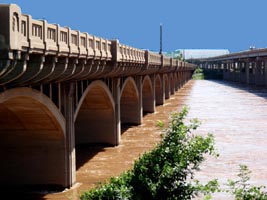|
Oklahoma - Route 66
11th Street Arkansas River Bridge, Tulsa
Built in 1916-1917 over the Arkansas River in Tulsa, the 11th Street Arkansas River Bridge is significant as the first major multi-span concrete bridge in Oklahoma. The bridge became a critical link between downtown Tulsa and the oil fields to the west. The mid-1910s was a period of great activity for Tulsa because of the booming oil economy. Across the Arkansas River, West Tulsa expanded rapidly to become a busy area for refining oil. The increase in traffic and trucking associated with the oil business made replacing the earlier wooden bridge a necessity.
Built by the Missouri Valley Bridge and Iron Company for $180,000, the 11th Street Arkansas River Bridge is a multi-span concrete arch bridge with 18 spans set on piers sunk into bedrock. Harrington, Howard and Ash of Kansas City, a firm that designed many bridges in the Midwest, engineered the bridge. Completed in 1917 and regarded as an architectural beauty with all modern features, the bridge, at 1,470 feet long and 34 feet wide, was one of the longest concrete structures in the Midwest. It supported a railroad track in the center and single lane of vehicular traffic on each side with sidewalks adjacent to the exterior lanes. The original design included a classical balustrade and Victorian-era lighting. In 1929, the installation of new Art Deco style guardrails and lighting fixtures updated the bridge. These lights are no longer extant.
Tulsan Cyrus Avery served as County Commissioner from 1913 to 1916, and was involved with construction of the bridge. In 1924, the Federal Government appointed Avery as a consulting highway specialist and assigned him the task of creating a U.S. highway system. Recognizing the economic impacts of these highways, Avery became a strong proponent of a route from Chicago to Los Angeles that would pass through his hometown of Tulsa. Already in existence as the primary crossing over the Arkansas River, the 11th Street Bridge became a major determining factor in defining the path of Route 66 to and through Tulsa.
A project in 1934 widened the bridge to its present width of 52 feet 8 inches and included construction of a second arch structure downstream of the 1916 structure and the connection of the new and old bridges with a single deck. New sidewalks were also built on both sides of the bridge. After completion of the project, the new 40-feet curb-to-curb width allowed the bridge to accommodate four lanes of traffic. The bridge remained in service until 1980, when it closed to traffic. In 1996, the bridge was listed in the National Register of Historic Places.
In 2003, the voters of Tulsa County approved a series of projects as part of the Vision 2025 initiative, one of which involves promoting and enhancing Route 66 in Tulsa. Plans are underway to implement the Vision 2025 projects with repairs to the 11th Street Bridge and the opening of a visitor center at the site. In 2004, the bridge officially received a new name, the “Cyrus Avery Route 66 Memorial Bridge,” in honor of the man responsible for bringing Route 66 through Tulsa.
|
The 11th Street Arkansas River Bridge spans the Arkansas River on historic Route 66 between the Southwest Boulevard Bridge and Interstate 244 Bridge in Tulsa, OK.

11th Street Arkansas River Bridge
National Park Service
Route 66 Corridor Preservation Program

11th Street Arkansas River Bridge
National Park Service
Route 66 Corridor Preservation Program
|





